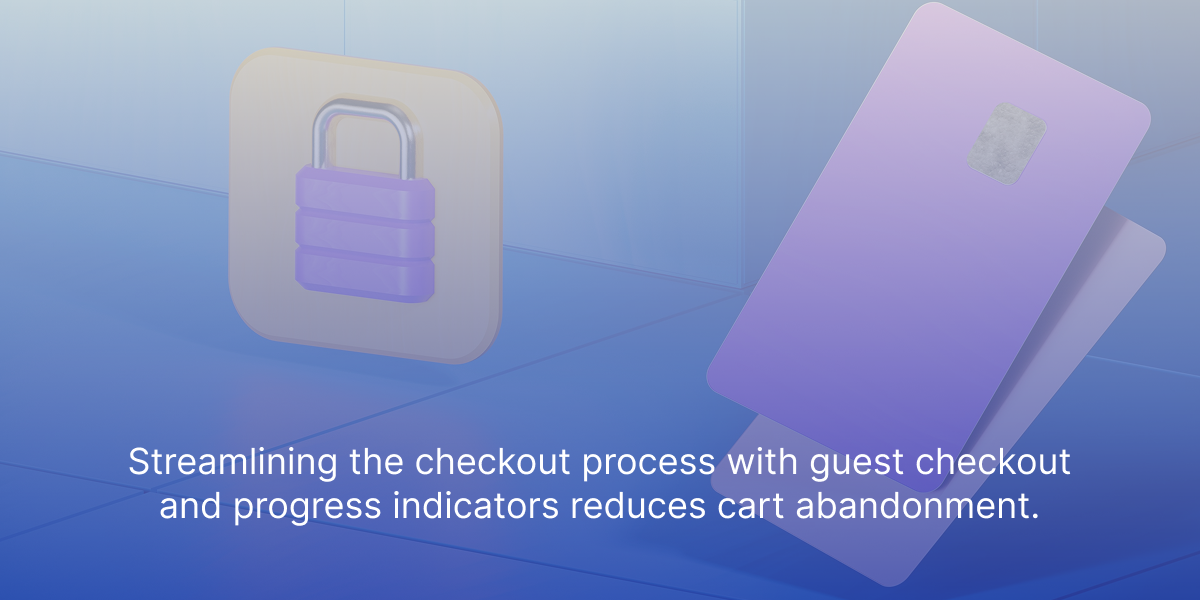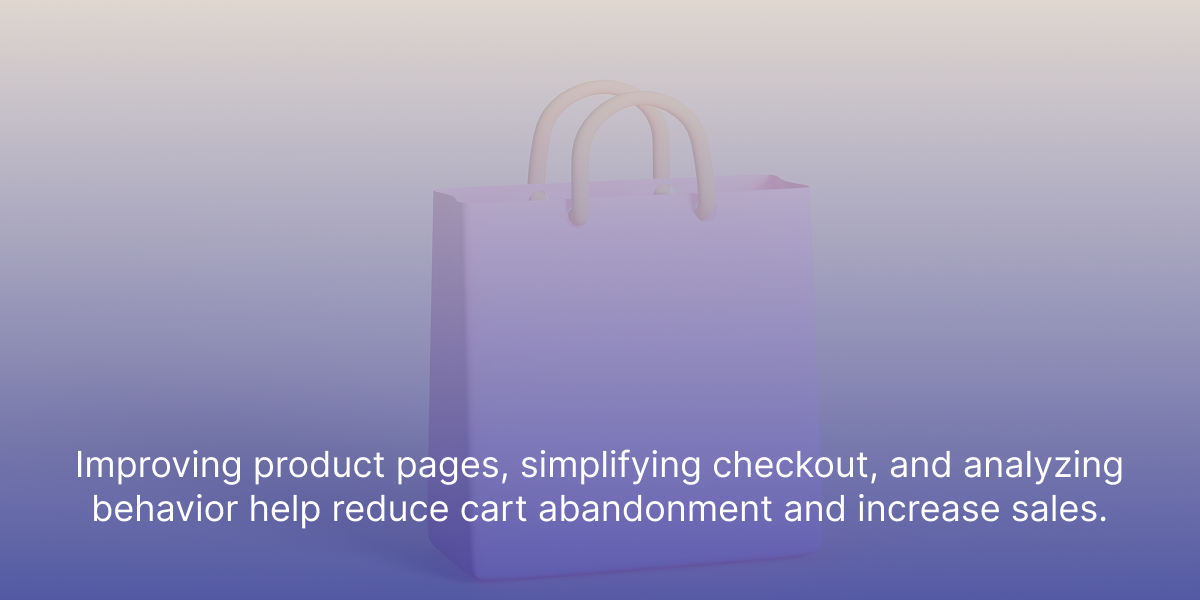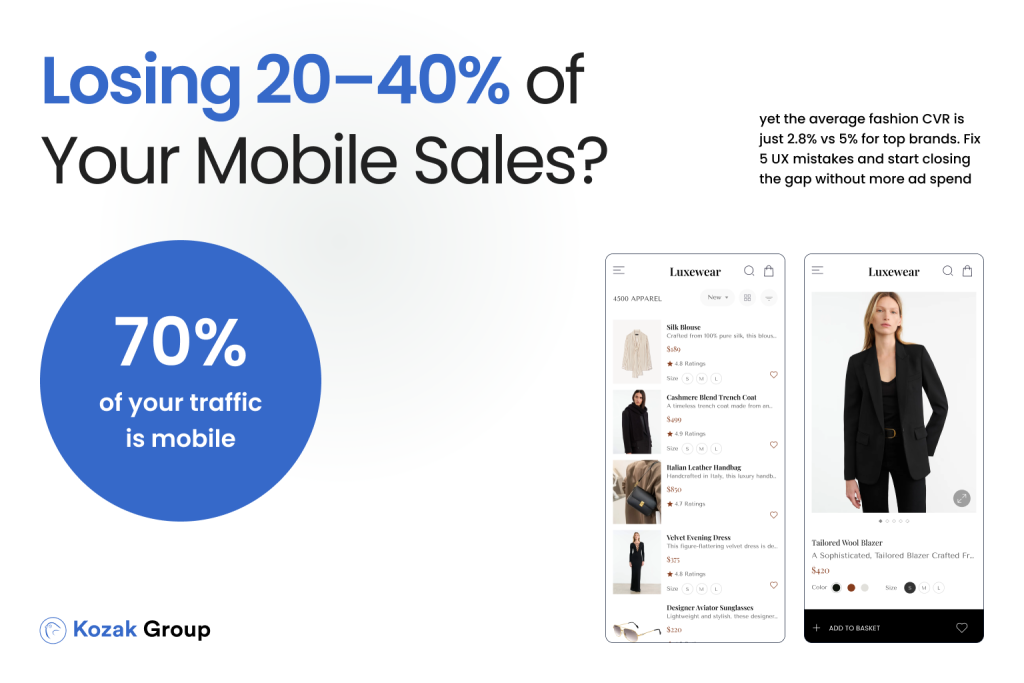Want to improve UX for eCommerce and drive more sales? Showcasing a variety of images for your best selling products is crucial, as it helps potential buyers evaluate whether the products meet their needs. This guide explains how to create better shopping experiences with effective design, easy checkout, and mobile optimization. Let’s dive into these strategies to enhance your online store.
Key Takeaways
- Investing in eCommerce UX leads to substantial returns, enhancing customer satisfaction and decreasing bounce rates through improved navigation and functional design.
- Optimizing the checkout flow and mobile experience is critical to minimize cart abandonment, with features like guest checkout and one-click payment options significantly improving conversion rates.
- Utilizing analytics tools and conducting user testing are essential strategies for understanding user behavior and enhancing the overall eCommerce experience.
- Ensuring visual consistency in branding is crucial for establishing brand recognition and fostering trust among users. Aligning color schemes, fonts, and logos across your website can enhance user engagement and convey your brand’s identity.
- An optimized checkout page is vital for enhancing the shopping experience and reducing cart abandonment. Implementing UX design strategies such as displaying product details, offering editing options for the order summary, and building trust through secure payment messaging can make the checkout process smooth and efficient.
Introduction to eCommerce UX

In today’s competitive market, ensuring a seamless and enjoyable user experience is paramount. Customers expect fast-loading pages, intuitive navigation, and easy access to product information. By focusing on these aspects, online retailers can create a user-friendly environment that encourages visitors to stay longer, explore more products, and complete their purchases. This not only boosts conversion rates but also fosters a sense of trust and reliability, which is crucial for building long-term customer relationships.
Understanding eCommerce UX

Allocating resources toward enhancing the ecommerce user experience brings substantial rewards: every dollar spent can generate up to $100 in return. Creating an inviting online space not only draws new visitors, but also captivates them—increasing engagement levels that drive purchases while building trustworthiness and promoting brand loyalty among users—which can lead to increased revenue without necessarily expanding site traffic. A primary objective within this realm is diminishing barriers for users thus boosting their interaction with your platform and catalyzing more sales. A well-designed eCommerce UX can significantly boost conversion rates.
To ensure efficacy in ecommerce ux strategies, it involves embracing established guidelines informed by comprehensive research into best practices. These guideposts are essential because they resonate with actual consumer preferences and requirements. Gaining insights into who exactly comprises your target audience forms a cornerstone upon which you shape your virtual storefront – a move crucial for maximizing both usability factors like effortless navigation alongside product discoverability – with an ultimate endgame of heightening shopper satisfaction through thoughtful design choices.
Prioritize Functional Design
E-commerce websites are designed to facilitate every step of the user journey, addressing their requirements efficiently. The focus is on creating a user interface that not only functions smoothly but also enhances the entire experience for users. Top-performing e-commerce sites give priority to quick load times and simplicity in navigation rather than purely aesthetic elements. While visual appeal has its importance, practicality reigns supreme in e-commerce site design.
It is crucial to consider both mobile and desktop user experiences in website design. Major companies often prioritize mobile-first designs, but optimizing the desktop website remains essential for overall user engagement and conversion rates.
Stores with intuitive online store navigation tend to retain visitors better, signifying that functional design plays a pivotal role in maintaining user interest. A well-executed e-commerce strategy emphasizes swift performance and effortless online store maneuverability as key goals. By making it easy for customers to navigate and interact with the website, businesses can significantly lower bounce rates.
By concentrating on essential design strategies focused on functionality, online stores can substantially improve engagement levels among users while integrating interactive elements crucial for successful commerce operations online.
Simplify the Checkout Flow

Unfortunately, despite its importance in minimizing input mistakes and enhancing number verification, autoformatting for credit card numbers is not implemented on 40% of websites, leading to potential customer dissatisfaction. When requesting customer details during checkout, it’s advisable to start with email capture then proceed sequentially with name collection followed by phone number procurement before addressing shipping information payment specifics should be requested lastly – all while ensuring an easily viewed summary section featuring selected items for enhanced user interaction throughout account creation processes. A progress bar visually indicates the steps completed and the current step in the checkout flow, aiding customers in understanding their purchase journey and navigating through it more efficiently.
Secure indicators such as trust badges from security providers or recognizable logos from payment companies alongside supportive messages serve as reinforcement during the transaction process bolstering confidence and fostering trust amongst users Collapsing previously completed stages in the process helps minimize excessive information thereby maintaining focus on impending actions which ultimately serves elevate overall completion rates when coupled sparing distractions elsewhere within checkout proceedings.
Optimize Mobile Sites
Nearly 50% of online traffic originates from mobile devices, underscoring the importance for ecommerce websites to be mobile-friendly. Many ecommerce stores are experiencing a significant increase in traffic from mobile devices compared to desktops. Adopting a mobile-first strategy, where designs are first tailored to smaller screens before being scaled up for larger displays, is crucial in emphasizing key functionalities and accommodating users on various devices. A failure to present responsive design might result in turning away those using smartphones or tablets due to inadequate adaptation across different device dimensions.
Incorporating a range of payment options such as digital wallets along with established payment methods can promote convenience for customers and reduce instances of cart abandonment. The adoption of one-tap purchasing solutions like Apple Pay, Google Pay, or PayPal simplifies the buying process on mobile platforms. These practices enhance not just the user experience on portable gadgets, but also contribute significantly towards increasing conversions and heightening overall consumer contentment.
Enhance Product Pages

Adding multiple visuals and videos related to the product can align with user expectations by providing an expanded perspective on the item being considered. Shoppers often look for various views of a product in order to evaluate aspects like hue, fit, and material texture more accurately. Utilizing product videos for top-selling or complicated items can further enhance user understanding and interest.
Embedding content created by consumers within eCommerce sites lends authenticity which has a positive impact on shoppers’ decision-making processes. Such content includes both praise-filled comments from satisfied buyers as well as critical feedback from less pleased ones. This mix enhances transparency while aiding prospective buyers during their selection process. The careful improvement of product description segments across websites promises marked gains in customer interaction levels and subsequent rates at which visitors convert into paying customers.
Improve Online Store Navigation
A large number of ecommerce sites struggle with providing effective navigation, as 76% are considered average or below in this regard. This presents an opportunity for e-commerce platforms to prioritize navigational efficiency and streamline the user path by reducing hurdles. With a staggering 85% of online stores not organizing their subcategories in an accessible manner, users often feel swamped. 91% incorrectly segregate products into separate categories despite shared characteristics. For e commerce websites seeking success, rectifying these navigation issues is paramount.
Making online store navigation intuitive is crucial to enhance the user experience. Effective navigation should require minimal conscious thought from users, allowing them to find products easily. This includes the use of clear labels, recognizable icons, and features like breadcrumbs and search functionality that guide users through the website seamlessly.
On many intermediary category pages across ecommerce platforms, there’s a noticeable absence of clearly defined subcategories affecting approximately 71% of such sites – a factor that complicates the browsing experience for visitors. Diminishing usability is the fact that half (52%) fail to distinguish interactive elements within their interface effectively creating confusion regarding clickable areas.
User orientation within an online store’s navigation suffers on numerous sites – 91% do not adequately indicate where a user currently stands within the structure – an essential aspect for guiding shoppers through their journey. The presence of intrusive advertisements compounds this problem: over half (52%) display aggressive marketing on homepages which disrupts exploration and may lead to frustration during product searches. By improving these aspects related to navigating online stores, users can greatly boost both user engagement and overall satisfaction with the shopping experience.
Utilize High-Quality Images

To fully convey the intricacies of a product, such as its color, fit, and texture, it is advised that each item be presented from multiple perspectives. A minimum of three to five images per product is suggested for users to thoroughly inspect the details they are interested in.
High-quality visual content on websites also garners favor from search engines, resulting in better organic discoverability. Employing superior-quality product photographs not only elevates user experience but also boosts recognition of the brand across web pages.
Additionally, well-structured product categories are crucial for user navigation on e-commerce sites. Clear and selectable parent categories enhance user experience by allowing customers to explore broad product categories before making more specific choices.
Implement User-Centered Copy
Grasping the purpose behind a user’s actions is essential for crafting web content that addresses their requirements effectively. Brands must adopt the viewpoint of prospective customers who may not have been exposed to other sections of their website when devising text for these sites. Disregarding this can result in overlooking both the path and the necessities specific to each user.
Elements like discount fields and high-quality visuals can significantly influence potential customers’ purchasing decisions and enhance their overall shopping experience.
Copy geared towards users ought to echo their style and preferences, establishing a connection with them through relevance and personalization. It should offer direct guidance while providing enough context to ensure an effortless experience as they navigate through the site. Choosing precise wording enhances message clarity and helps maintain ease of reading.
Well-executed UX copy captivates its audience subtly, integrating itself naturally into the overall experience without drawing undue attention. Directions within such copy need to be unambiguous so as not disrupt or bewilder those using it during their journey on the site.
Speed Up Website Performance
Improving the loading speed of a website by just 0.1 seconds can lead to an increase in eCommerce conversion rates by up to 8.4%. The likelihood of users abandoning a site climbs steeply when the page load time exceeds 3 seconds, with half of them leaving at this point. Adopting advanced caching techniques is instrumental in boosting both the speed and efficiency of a website.
Website speed is crucial for user retention, as slow loading times can lead to high abandonment rates. To improve website speed, consider optimizing images, leveraging browser caching, and minimizing HTTP requests.
Employment of Content Delivery Networks (CDNs) serves to expedite content delivery by minimizing the physical distance between end-users and servers, thus speeding up loading times significantly. To Accelerate webpage rendering, it’s crucial to eliminate resources that block rendering since they hinder prompt interactivity and detract from overall user experience. Overdesigning websites with superfluous ornate elements could result in increased load times that may negatively affect user satisfaction.
Enhanced web performance is directly linked not only to superior levels of user satisfaction but also heightened engagement across your platform as faster speeds contribute substantially towards crafting positive experiences for visitors.
Leverage Analytics Tools
Leveraging data analytics is crucial for optimizing eCommerce websites to align with consumer needs. Tracking user behavior sheds light on the way visitors interact with various website elements, pinpointing both successful features and areas where users tend to abandon their journey. By employing a suite of analytics tools, one can gain an enriched perspective of the customer’s experience throughout their entire visit.
Incorporating heat map technology like Hotjar enables in-depth analysis of user clicks and interactions across web pages, revealing the points that capture the most engagement from visitors. Tools such as Google Analytics provide important statistics regarding visitor behavior including bounce rates, duration of page visits, and navigation patterns among users. Effective search results are crucial when user searches for specific products, as accurate retrieval and display of relevant items ensure users find what they are looking for, preventing the misconception that the site lacks the desired product.
Utilizing session replay software allows for a closer examination of how actual customers navigate through the site by providing playbacks of their sessions. This insight into real-time usage facilitates identifying low-performing segments and confusing aspects within pages which can be modified accordingly. Employing these diverse analytical resources effectively increases conversion rates while simultaneously boosting levels of interaction with users on eCommerce platforms.
Conduct User Testing
Usability testing plays a vital role in enhancing the user experience to more closely meet the needs of users. By employing the ‘Think Aloud’ method, participants articulate their thought processes while interacting with a website, revealing their cognitive patterns. Quantitative usability research offers tangible data such as task completion times and rates of success.
Adhering to ux best practices is essential for optimizing the user experience in ecommerce, leading to smoother customer journeys, increased conversion rates, and overall improved business success.
Utilizing five-second tests can swiftly and efficiently determine how clearly a website communicates its brand message. Sessions replay tools grant qualitative observations by enabling analysts to watch actual interactions from users and pinpoint any issues related to usability.
Monitoring genuine target users while they complete tasks permits researchers to record both obstacles faced by these individuals as well as instances of effortless interaction. Testing with users who are not familiar with the design helps in detecting potential usability flaws that might be missed by seasoned designers. Engaging in user testing is instrumental for fostering a positive user experience alongside an uninterrupted customer journey.
Offer Proactive Customer Service
Proactive customer support involves anticipating and addressing customer needs before they arise. Using automation and AI can significantly enhance the efficiency of proactive customer service efforts. Providing agents with comprehensive customer profiles allows for more personalized service.
A positive customer experience enhances brand interaction and can significantly impact return on investment. Forecasting customer demand can optimize staffing levels and improve service during peak times. Actively seeking customer feedback enhances brand perception and builds customer loyalty. Live chat tools provide immediate channels for collecting customer feedback while resolving queries.
Employing sentiment analysis helps prioritize customer issues based on their emotional state. Offering proactive customer service can lead to higher customer satisfaction and user engagement.
Personalize the Shopping Experience

Encouraging customer loyalty and repeat business by facilitating future purchases is crucial. Offering exclusive deals, discounts, and a seamless user experience can significantly increase the likelihood of shoppers returning after their initial purchase.
By engaging in personalization strategies like upselling or suggesting additional complementary items, online merchants could see a rise in average order value-an increase that might reach 12%. Providing individualized customer support informed by specific client profiles greatly aids in maintaining consumer loyalty over time. The employment of dynamic content which adapts according to each user’s behavior patterns and demographic information is another powerful tool that markedly improves the retail experience provided through digital platforms like custom features.
Catering specifically to an individual shopper’s tastes not only fosters an agreeable user experience but also amplifies overall contentment among patrons-which is indispensable for ecommerce success.
Maintain Consistent Product Attributes
Maintaining a uniform display of information among different product options is essential for facilitating user comparison. Regrettably, 68% of websites fail to present product characteristics uniformly in their listing items. To support user comparison efforts, it’s important that these attributes are consistently displayed across all list items.
Accurately categorizing products for search functionality on e-commerce sites is crucial. If various synonyms related to a particular product category are not recognized, users may not find the products they are looking for, potentially resulting in a lack of relevant results and a negative user experience.
Employing varying font styles, bullet points, line spacing and breaks can significantly improve the discernibility of informational elements within design features. By rendering each element visually distinct within the list items, users will find it easier to scan and interpret the provided information.
A consistent depiction of product details not only enhances the online shopping journey but also assists customers in making well-informed choices regarding their purchases.
Provide Clear Delivery Information
Incorporating a delivery estimation tool can greatly bolster consumer confidence by making the shipping process more transparent. Despite this, 37% of websites choose not to provide an estimated ‘Delivery Date’, preferring instead to indicate ‘Shipping Speed’ as a forecast for when packages will arrive. It is recommended that websites specify the ‘Delivery Date’ rather than just stating the ‘Shipping Speed’.
Clear delivery information can significantly influence potential customers’ purchasing decisions, making them more likely to complete a purchase.
By providing comprehensive delivery details, companies can diminish customer service inquiries and improve overall satisfaction through effective expectation management. When order processing and shipping stages are illustrated with clear visual timelines, it helps customers gain a better understanding.
When direct customers have access to unambiguous delivery information, they form a well-informed group that tends to remind shoppers about their shopping experience with greater certainty in completing purchases.
Avoid Common UX Mistakes

- Slow elements
- Poor navigation
- Broken links
- Confusing copy
- Forced user journeys
Successful e-commerce sites follow data-driven best practices to improve user experience and conversion rates. Many prominent e-commerce companies, particularly those in the Fortune 500, implement these guidelines to enhance their performance in the competitive e-commerce landscape.
Forcing users to follow an artificial journey can lead to frustration and abandonment. Rapid clicking from users can indicate frustration or confusion, which often arises from non-responsive buttons or unclear instructions, failing to meet users’ expectations.
Slow elements in design can significantly degrade user experience and decrease conversions. Memory-intensive elements that slow down loading times are best avoided to improve performance. Overusing pop-ups can distract users and negatively impact their shopping experience.
A clear visual hierarchy mitigates ‘choice paralysis’ by establishing priorities, facilitating quicker decisions. Avoiding common UX mistakes leads to a more positive user experience and higher engagement.
Encourage User Feedback
Requesting feedback from users is essential for ongoing enhancement and creating a more intuitive design. Gathering both qualitative and quantitative user insights can reveal issues with the user experience (UX). By integrating feedback forms into web pages, it allows visitors to effortlessly communicate their experiences.
Clarity and conciseness in website content are crucial to enhance the experience of website visitors. Providing essential information quickly on landing pages captures user interest and facilitates a seamless eCommerce user experience.
By dividing email lists into segments, the pertinence and impact of feedback surveys are increased. Taking action on the recommendations provided by users can help foster a sense of community around your brand. Actively seeking out user input plays a significant role in refining the user experience and elevating customer satisfaction.
Use Visual Hierarchy
By creating a clear visual hierarchy, the burden on cognitive processing is lessened, facilitating users in finding and assimilating information with ease. Scaling elements appropriately ensures that crucial content stands out through increased visibility of larger-sized items.
The use of contrasting colors among various components also boosts their visual separation, leading to a more defined hierarchical structure. Employing a well-defined visual hierarchy can significantly enhance both the user interface and the overall user experience.
Implementing Best Practices
Implementing best practices in eCommerce UX design is crucial for creating a seamless and intuitive user experience. This includes designing an intuitive online store navigation, optimizing product pages with high-quality images and detailed product descriptions, and streamlining the checkout flow. Additionally, considering user expectations and behavior, such as providing a guest checkout option and offering multiple payment methods, can significantly improve the overall user experience. By incorporating these best practices, eCommerce sites can reduce cart abandonment rates, increase conversion rates, and ultimately drive more sales.
A well-structured navigation system allows users to find what they are looking for quickly and effortlessly. High-quality images and comprehensive product descriptions help customers make informed decisions, reducing the likelihood of returns and negative reviews. Streamlining the checkout process by minimizing the number of steps and offering various payment options can further enhance the user experience, making it more likely for customers to complete their purchases. By focusing on these key areas, eCommerce stores can create a more engaging and satisfying shopping experience for their customers.
Boosting Conversions and Reducing Cart Abandonment

Optimizing product detail pages involves providing high-quality images, detailed descriptions, and clear pricing information. Simplifying the checkout process by reducing the number of steps and offering a guest checkout option can significantly decrease cart abandonment rates. Analytics tools provide valuable insights into user behavior, helping businesses understand where customers drop off and what changes can be made to improve the user journey. Regular user testing ensures that the website remains user-friendly and meets the evolving needs of its audience, ultimately leading to higher conversion rates and greater customer satisfaction.
Summary
In essence, refining eCommerce UX demands a holistic approach that encompasses grasping what users want and applying sophisticated design techniques. It’s crucial to focus on practical designs, simplify the checkout experience, and ensure mobile user optimization as part of this comprehensive strategy. Significantly boosting customer satisfaction involves elevating product pages with high-quality images and streamlining site navigation.
E-commerce design is fundamentally linked to the category taxonomy, which involves how site content is organized and classified. A well-structured category navigation is crucial for enhancing user experience by making products more accessible on an e-commerce platform.
For online retailers seeking to cultivate a frictionless and delightful shopping journey for their customers, these tactics are imperative. They enhance sales while building customer loyalty. A successful eCommerce website hinges on ongoing enhancements tailored to consumer feedback. Dedication to improving your eCommerce UX will undoubtedly lead to greater levels of customer satisfaction and an upsurge in profits.





